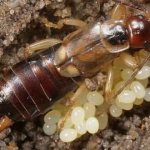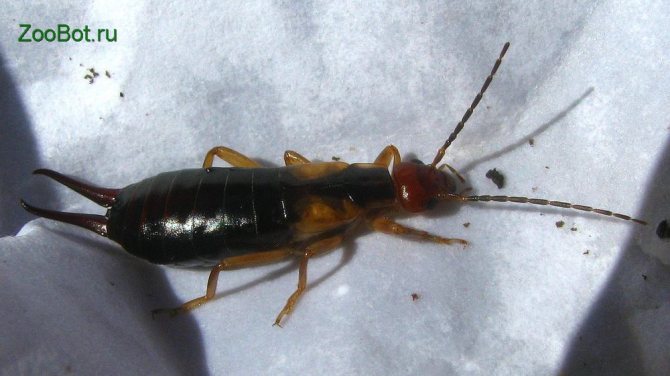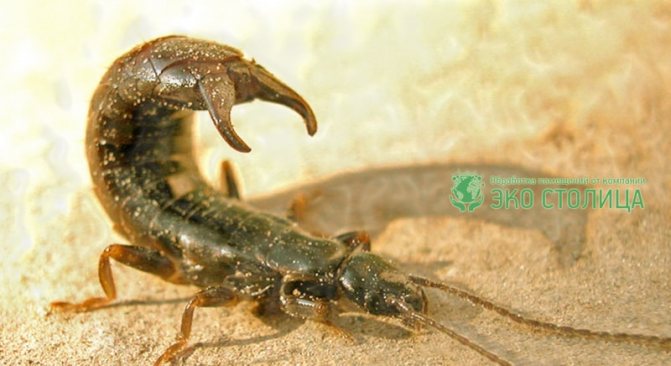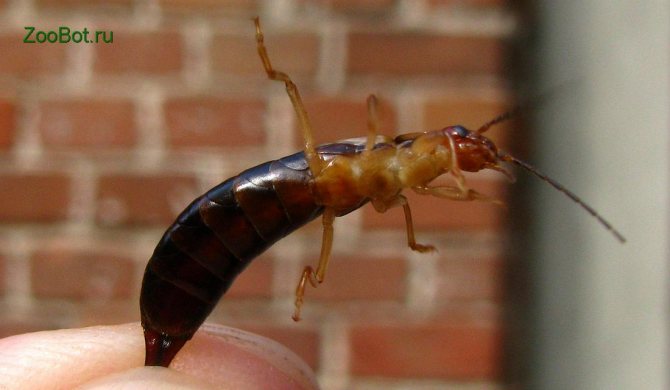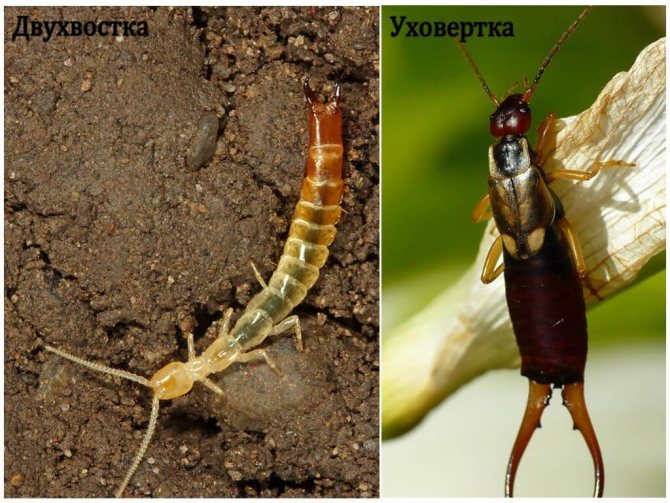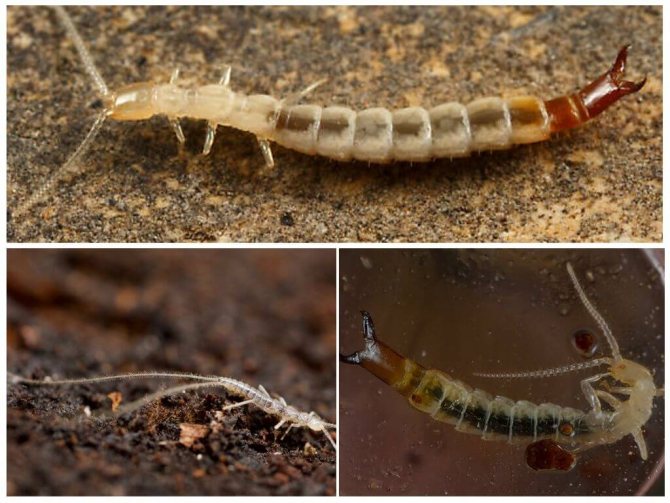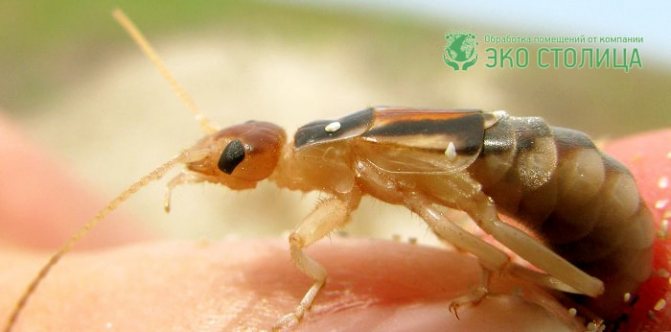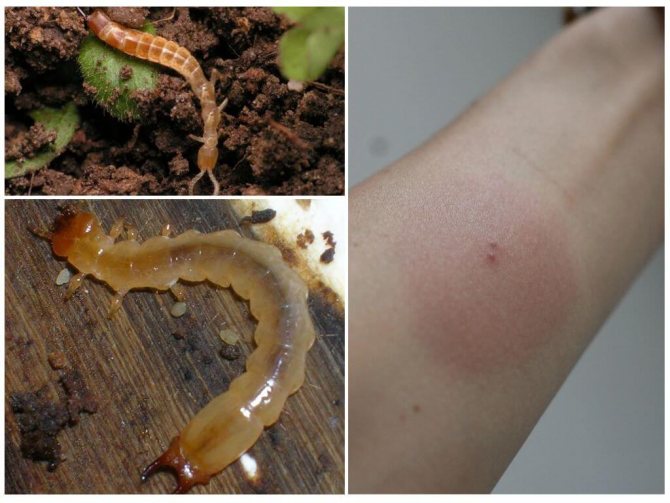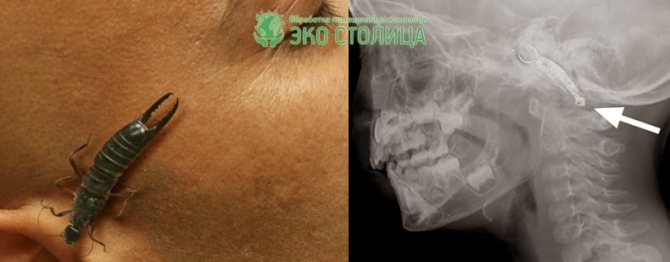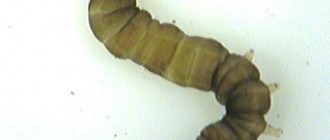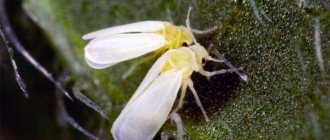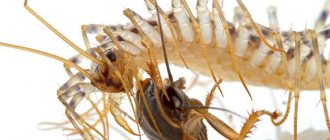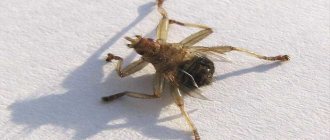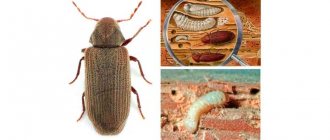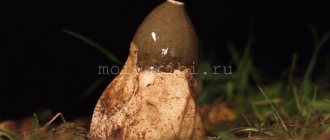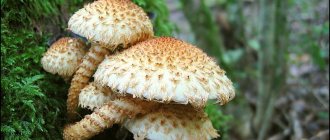- the main
- Disinsection
- Earwigs
- How to get rid of two-tails
Fork-tails or two-tails are small insects leading a secretive lifestyle, whose appearance is usually very frightening to people. The pointed ends of the double tail, which gave the name to the insect, can indeed become a formidable weapon in a moment of danger. But in ordinary life, the double tail or cerci serve the insect for completely different purposes - they help to move, hold the caught insects, and are used when reversing.
Dvuhvostok often settle next to human housing or in outbuildings. You can meet insects that prefer moist and cool zones in cellars and basements, pantries. An insect can also settle in an apartment. If you accidentally step next to a lurking insect, you can get a painful bite.
Of course, such a neighborhood causes a lot of trouble for residents. How to get rid of two-tails as quickly and safely as possible, read the article.
Two-tailed and earwig
The true two-tailed, or fork-tailed, belongs to the order of six-legged occultus, and the earwig belongs to the order of leathery-winged insects. The two-tailed is more often a small arthropod, rarely reaching 6 mm in length.
The earwig is up to 1.5 cm long. The two-tailed earwig has no eyes, and the earwig has small eyes on its head. Light passes through the body of the fork-tailed, and the body of a relative has a chestnut-brown back and a dark brown abdomen.
Some two-tailed species are capable of shedding their "tails" like lizards when needed, then recovering.
Hence the conclusion: an ordinary earwig settles in houses, and not a two-tailed earwig. And they call it an earwig because the wings of an insect, when unfolded, look like a human ear.
Development features
Earwigs are characterized by incomplete transformation. In the first year of life, they go through all stages - from egg to imago. Closer to cold weather and after fertilization, which takes place in August-September, the female, with the help and support of the male, begins to prepare the nest. In it the two-tails hibernate, but the male rarely survives until spring.
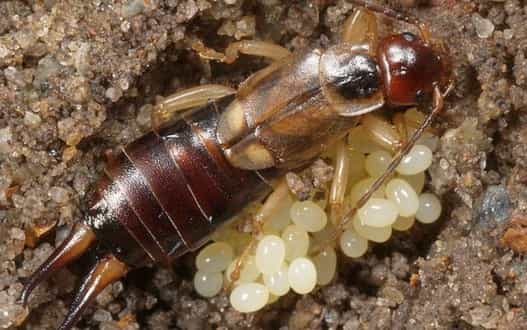
Earwigs make two clutches. The winter one has up to fifty eggs. Re-laying will be twice as modest. The nests look like in the photo. Usually there are no more than 20 eggs in early spring.
After laying eggs, the female is in the nest all the time and takes care of the clutch. In relation to other individuals, it experiences aggression - it does not allow anyone to approach the nest, including the male.
The incubation period lasts up to 85 days. Larvae from the first clutch are born in May. The second litter will hatch in June. By August, both of them will reach the state of imago. During the summer, the larvae will molt 4 times.
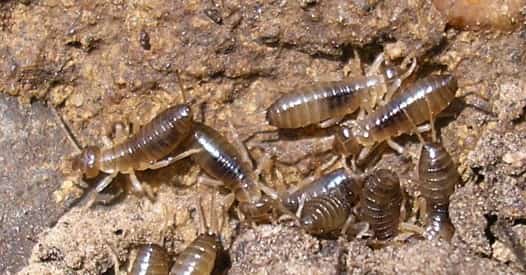

The body length of a newborn earwig larva is no more than 4 mm. Outwardly, it looks like an adult. But since the forceps are still too small, it is difficult for an inexperienced eye to see the future two-tail, even in a photograph.
Earwigs: benefit or harm
Earwigs are omnivorous predators. In household plots, they gnaw off the stems and leaves of young plants, eat up the color. In the spring, thin stalks of seedlings on the windows are gnawed at the house. In beekeepers, they harm bees by feeding on honey and bee bread. But tangible harm is caused by the larvae: they gnaw both greens, and fruits and vegetables, and petals on flowers.
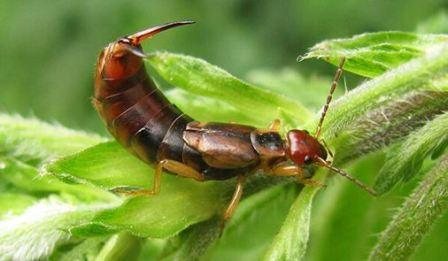

It enjoys insect and pests: ticks, aphids and other gardeners eating crops. In the house, such an assistant will destroy small insects.
The disadvantages against earwigs in the house prevail over the advantages, so such "helpers" should be kicked out or destroyed.
Danger to the garden
The earwig unfolds the main sabotage activity not in the ears of a person, but in his garden.
The earwig is dangerous mainly because a large population can cause significant harm to garden plants. Let's see how the insect's wrecking activity is expressed:
- During feeding, the earwig individual makes holes in the foliage, which can lead to the death of the plant;
- Eats young shoots, berries and fruits, making them unsuitable for food;
- Destroys house plants and seedlings;
- Contaminates crops with excrement.
It is worth noting that the earwig is taken for cultivated plants mainly in dry years, which greatly increases agricultural damage.
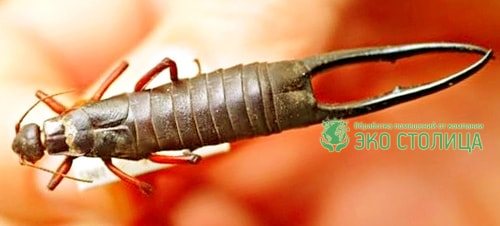

If insects are not controlled, the losses from earwigs can be very significant.
As already mentioned, plant food is also included in the insect's diet - mosses, lichens, plant pollen, as well as agricultural and flower crops.
Among the main delicacies of the insect are grapes, peaches, dahlias, chrysanthemums. An earwig can get inside fruits and berries only through passages made by some other insects (caterpillars, for example).
Beekeepers dislike the earwig. One individual that climbed into the hive can destroy up to 300 grams of honey, pollen and bee bread at a time. From time to time, the parasite can feast on the bees themselves.
Common earwig, description
This insect is also called the European earwig, tick or pinch.
The common earwig hunts at dusk or at night, and when it is light it sleeps in a dark damp shelter. Sometimes it is shown during the day. He knows how to fly, keeping his body upright, but prefers to crawl. After the flight, the wings fold in 2 times and are covered by the elytra.
Insect with an oblong body and a flattened heart-shaped head, oblique downward. The front of the head has long, threadlike antennae. On the abdomen there are 3 pairs of yellowish-brown legs.
The back of the body is equipped with forceps, similar to tails, which the insect lifts upwards during defense. These forceps are also used during mating. Males are longer than females, body is 15-17 mm, tails are thicker, rounded, denticles on the inner side. Females are up to 14 mm long, tails are straightened and without denticles.
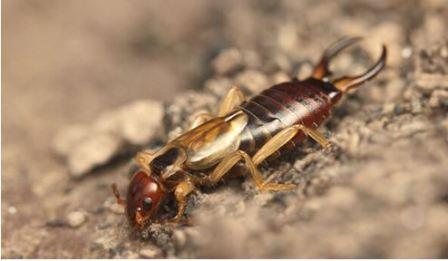

For food, the common earwig chooses mycelium, algae, fruit and berry residues, food from the human table. She gnaws indoor plants, and loves to feast on petals of decorative flowers on the site. Does not refuse to eat the larvae of other insects and adults - those who are smaller in size.
How the pinch reproduces and develops
These insects produce offspring once every 12 months. They mate more often in September, then, if they live on the street, they hide in burrows. During the mating season, the male flaps its tails, strokes and grabs the female, but does not hold it. If it receives "good", then it connects with the female, turning its belly. This is how the “lady” moves and feeds.
Fertilization is internal, and in February - March, the female makes, in a chosen and equipped place, a clutch with 30-55 eggs. Protects, maintains cleanliness and moisture, and drives the male away.
After 2-2.5 months, small nymphs come out. The earwig protects the fry and feeds the regurgitated food until the 2nd molt has passed.
Sometimes the mother dies, then the babies, at first, feed on her body. Then, at 2 months of age, they go out to hunt.By autumn, insects are able to reproduce. The life of earwigs is 12 months.
Chemical methods
Chemicals can be purchased in specialized stores to destroy various crawling and blood-sucking insects. Due to their high efficiency and speed of action, they are most often used by most people.
If you have no desire to do this on your own, then you can invite specialists and entrust them with the work of removing two-tails from your home.
But remember that these insects are not such a serious threat to resort to such radical methods. In addition, you will have to pay quite an impressive amount for the services of a pest control. Therefore, we will try to get rid of insects on our own.
The best aerosols
Along with dichlorvos, which is most often used to fight domestic insects, in stores you can find many other drugs that are less dangerous for animals and humans with a less pungent and unpleasant odor.
But still, before processing the apartment, it does not hurt to take some precautions. It is advisable to put the products in sealed containers and cabinets, send all family members together with pets outside for 3-4 hours
After a few hours, and that is how much is required for the action of the drug, it is necessary to collect the dead insects and carry out wet cleaning.
The following sprays and aerosols are the best drugs that can successfully poison the dvuhvostok:
- Reid;
- Combat;
- Raptor;
- Quick Byte;
- Off;
- Clean house.
Applying crayons
This poison is considered one of the most convenient to use. You just need to draw a small line along the baseboards or directly on them, as well as in other places that the dvuhvostki have chosen. You don't have to send your family outside.
The most famous protein is Mashenka. But, in addition to it, you can use other equally effective types of poison from two-tails:
- Tornado;
- Clean house;
- Brownie Proshka;
- Titanic;
- Nika.
The action of the chalk lasts about a month, after which the lines you drew must be washed off.
Aquafumigator Raptor
The main advantage of this miracle device is performance. Reviews of the owners say that just one application of this tool is enough so that these insects do not bother you throughout the season. Such a striking effect is associated with the presence in the composition of the active substance, which has the form of steam that can penetrate into any gap. Wherever pests are hiding, be it skirting boards, ventilation ducts in the bathroom or cracks in the floor, this device will detect and destroy them everywhere. This tool is ideal for summer residents who do not know how to get rid of dvuhvostok in the country.
So that you can quickly get rid of these insects with the help of an aquafumigator, we give instructions for its use:
- Remove the liquid sachet, the metal container with the active ingredient, and the plastic cup from the box.
- Remove the packaging from the metal container.
- Pour the liquid from the bag into a plastic cup.
- Place a glass of liquid in a metal container.
Now you need to leave the room, because at this moment a violent reaction will begin with the formation of steam. It takes 2-3 hours for the remedy to work, and during this time there should be no one in the house. Beforehand, you must open all internal doors and tightly close the entrance and windows.
Garden chemicals
Two-tails can enter a house with garden soil, which summer residents use to grow seedlings. To protect your home from this pest, you can use the following chemicals to decontaminate the soil:
- Insecticides for plants. The most famous of this group of drugs are Intavir, Iskra and others. Each of them must be applied strictly according to the instructions.
- Laundry soap solution.Insects do not tolerate its smell.
- Balm "Golden Star". It can be used to process boxes and flower pots before pouring garden soil into them. Unlike humans, insects smell of balm scares, from which they run away.
Is an ordinary earwig dangerous for humans
People are more often afraid of the pinching device because of the legend they hear about crawling into the ear. But the name is connected not with its turns in the ear, but with the similarity of the wings to the human ear, which the insect folds after flying.
Not a single case of penetration of an earwig into a person's ear cavity has been noticed. They are only able to pinch and pierce the skin of a person or a pet with forceps, and then for defense purposes.
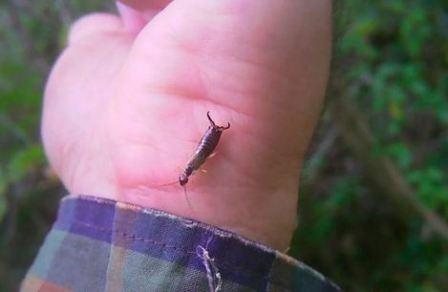

An itchy and slightly painful wound, but without poison, is treated with diluted alcohol or vinegar. People with allergic reactions should take an antihistamine and lubricate with Fenistil. Cannot be glued.
Reproduction
It is also surprising how two-tails breed. The fertilization process takes place outside the body of arthropods. Within a week, the male lays in the soil at least two hundred spermatophores (capsules with spermatozoa), which retain their properties for two days. The female collects these capsules with her genital opening, after which she lays eggs in the cracks in the soil (up to 50 larvae appear from one clutch). The offspring that do not experience metamorphosis is very similar to adult insects and differs only in smaller sizes.
How to get rid of earwigs in your home
An unpleasant moment if earwigs live in the house, when they crawl into socks, in underwear, hide in clothes.
Safe folk recipes against earwigs
one). They scare off aliens with herbs and aromatic oils: they do not like basil, rosemary, thyme, lavender and pyrethrum. Essential oil is dripped into an aroma lamp, and dried herbs are laid out in bunches or in fabric bags.
2). A wet rag, or a cut potato as a trap. It is worth considering that insects are fast-footed, so the rag is folded without hesitation and burned or packed in a plastic bag and thrown away. Another trap: a tin can with vegetable oil poured onto the bottom.
3). An ordinary earwig does not like the smell of vinegar, therefore, it is necessary to wipe it where these insects appear. Houseplants are also gently wiped with a solution. Add 50 ml of a 9% solution per 5 liters to the water for cleaning the floor and walls.
four). Boric acid is mixed with yolk and 1 cm balls are laid out where the "lodgers" come. This substance is poisonous to them. Change the bait once a week when dry. Sometimes powder is scattered, but out of the reach of children and pets.
five). Elimination of moisture.
Chemicals
Chemical preparations will reliably destroy or drive away the terrible insects. But, when working with insecticidal products, personal protective equipment is required. Using aerosols, they protect the respiratory tract. After gels and powders - wash your hands thoroughly.
There is no special remedy for earwigs, so those that are designed to combat crawling insects are purchased.
In difficult cases, if a massive invasion of insects is visible, or if there is no desire to fight on their own, they call an exterminator.
Pest prevention
It is much easier to prevent the appearance of two-tails in an apartment or a private house than to remove these insects later. To do this, you need to remember several important rules:
- On all windows and balcony openings, mosquito nets must be installed, which protect the house from the penetration of various insects.
- Never leave wet clothes or wet rags on the floor for a long time.
- Make sure that there is no increased dampness and humidity in the apartment.
- Monitor the condition of ventilation and sewer ducts.
- Water indoor plants in moderation.
- Do not dry washed clothes and linen in the room - only on the balcony or in the yard.
The dvuhvostka can appear in any room - both a city apartment and a country cottage. It is necessary to start fighting insects immediately after they are identified. For this purpose, various insecticidal preparations and effective folk remedies are used. Timely processing at home will help you quickly get rid of unwanted "guests".

